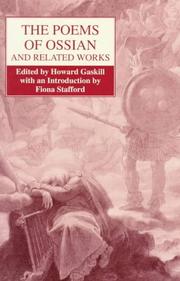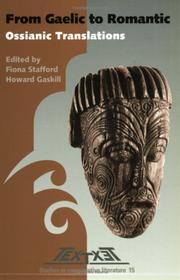| Listing 1 - 4 of 4 |
Sort by
|

ISBN: 1281298735 9786611298739 1847143016 9781847143013 9780826461353 0826461352 0826461352 9781281298737 6611298738 1847146007 Year: 2004 Publisher: London ; New York : Thoemmes Continuum,
Abstract | Keywords | Export | Availability | Bookmark
 Loading...
Loading...Choose an application
- Reference Manager
- EndNote
- RefWorks (Direct export to RefWorks)
The intellectual scope and cultural impact of British writers cannot be assessed without reference to their European fortunes. This collection of 20 essays, prepared by an international team of scholars, critics and translators, records the ways in which Macpherson's Ossian has been received, translated and published in different areas of Europe. The Ossian poems caused a sensation on their first appearance in the 1760's. Indeed, there is hardly a major Romantic poet on whom they failed to make a significant impression. The essays brought together in this volume explore the reception of Ossian
Literary forgeries and mystifications --- European literature --- Mythology, Celtic, in literature. --- Celts in literature. --- History --- Scottish influences. --- Macpherson, James, --- Ossian, --- Oisín, --- Makferson, Džejms --- Influence. --- Appreciation --- Translations --- History and criticism. --- In literature. --- 18th century --- Celts in literature --- Macpherson, James --- Influence --- Europe --- History and criticism --- Mythology [Celtic ] --- In literature --- Scottish influences --- Ossian

ISBN: 0748607072 9780748607075 0191794856 Year: 1996 Publisher: Edinburgh Edinburgh University Press
Abstract | Keywords | Export | Availability | Bookmark
 Loading...
Loading...Choose an application
- Reference Manager
- EndNote
- RefWorks (Direct export to RefWorks)
English literature --- Ossian --- Mythology, Celtic --- Ossian, --- Literary forgeries and mystifications --- Bards and bardism --- Celts --- Poetry. --- English poetry. --- Early works to 1800. --- Ossian [Fictitious character]

ISBN: 9004648291 9042007818 Year: 1998 Publisher: Amsterdam : Brill Academic Publishers,
Abstract | Keywords | Export | Availability | Bookmark
 Loading...
Loading...Choose an application
- Reference Manager
- EndNote
- RefWorks (Direct export to RefWorks)
The appearance of James Macpherson's Ossian in the 1760s caused an international sensation. The discovery of poetic fragments that seemed to have survived in the Highlands of Scotland for some 1500 years gripped the imagination of the reading public, who seized eagerly on the newly available texts for glimpses of a lost primitive world. That Macpherson's versions of the ancient heroic verse were more creative adaptations of the oral tradition than literal translations of a clearly identifiable original may have exercised contemporary antiquarians and contributed eventually to a decline in the popularity of Ossian. Yet for most early readers, as for generations of enthusiastic followers, what mattered was not the accuracy of the translation, but the excitement of encountering the primitive, and the mood engendered by the process of reading. The essays in this collection represent an attempt by late twentieth-century readers to chart the cultural currents that flowed into Macpherson's texts, and to examine their peculiar energy. Scholars distinguished in the fields of Gaelic, German, Irish, Scottish, French, English and American literature, language, history and cultural studies have each contributed to the exploration of Macpherson's achievement, with the aim of situating his notoriously elusive texts in a web of diverse contexts. Important new research into the traditional Gaelic sources is placed side by side with discussions of the more immediate political impetus of his poetry, while studies of the reception of Ossian in Scotland, Germany, France and England are part of the larger recognition of the cultural significance of Macpherson's work, and its importance to issues of fragmentation, liminality, colonialism, national identity, sensibility and gender.
Literary forgeries and mystifications. --- Macpherson, James, --- Ossian,
Book
ISBN: 1783746572 1783746556 1783746564 Year: 2019 Publisher: Open Book Publishers
Abstract | Keywords | Export | Availability | Bookmark
 Loading...
Loading...Choose an application
- Reference Manager
- EndNote
- RefWorks (Direct export to RefWorks)
"Friedrich Hölderlin’s only novel, Hyperion (1797–99), is a fictional epistolary autobiography that juxtaposes narration with critical reflection. Returning to Greece after German exile, following his part in the abortive uprising against the occupying Turks (1770), and his failure as both a lover and a revolutionary, Hyperion assumes a hermitic existence, during which he writes his letters. Confronting and commenting on his own past, with all its joy and grief, the narrator undergoes a transformation that culminates in the realisation of his true vocation.Though Hölderlin is now established as a great lyric poet, recognition of his novel as a supreme achievement of European Romanticism has been belated in the Anglophone world. Incorporating the aesthetic evangelism that is a characteristic feature of the age, Hyperion preaches a message of redemption through beauty. The resolution of the contradictions and antinomies raised in the novel is found in the act of articulation itself. To a degree remarkable in a prose work of any length, what it means is inseparable from how it means. In this skilful translation, Gaskill conveys the beautiful music and rhythms of Hölderlin’s language to an English-speaking reader."
Hölderlin, Friedrich, --- Literature & literary studies --- Classic fiction (pre c 1945) --- Myth & legend told as fiction --- Friedrich Hölderlin --- novel --- Hyperion --- fictional epistolary autobiography --- European Romanticism --- Greece
| Listing 1 - 4 of 4 |
Sort by
|

 Search
Search Feedback
Feedback About UniCat
About UniCat  Help
Help News
News